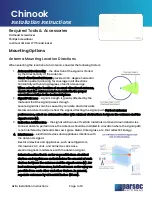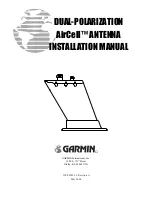
ADCP-75-110
•
Issue 2B
•
July 2001
Page 21
©
2001, ADC Telecommunications, Inc.
Whenever
possible, use conduit or a guideway such as the FiberGuide system to route the optical
links
between the DHU, the DEUs, and the DRUs. Avoid routing optical fibers through ladder type
cable
racks or troughs that do not provide sufficient support to limit bending or prevent accidental
damage.
Tie-wrapping is not recommended as a means of securing fiber optic cables. Provide
sufficient
slack at each unit for connecting each fiber to the required port. Fibers may be pre-
terminated
or terminated on-site using field-installable LC type connectors.
2.5 Coaxial Cable Requirements
The
DHU interfaces either locally (see Figure 8) or remotely (see Figure 9) with the BTS
through
coaxial cable connections. In a local interface with the BTS, coaxial cables are
required
to link the DHU with the LIU and the LIU with the BTS. In a remote interface,
coaxial
cables are required to link the DHU with the RIU and the RIU with the donor antenna.
The
DHU, LIU, and RIU are equipped with N-type female connectors for connecting the
forward
and reverse path coaxial cables. Use high performance, flexible, low loss 50-ohm
coaxial
communications cable (RG 400 or equivalent) for all coaxial connections.
2.6 System Expansion Planning
The
DEU enables 6-way expansion of any optical port. This makes it possible to add more
DRUs
without having to install additional DHUs. Each DHU is equipped with six optical
ports.
If more than six DRUs are required by the application, a DEU may be connected to one
of
the optical ports at the DHU which expands that port to six ports. If still more optical ports
are
required, then a second DEU may be connected to the DHU or a second DEU may be
connected
to the first DEU. The ability to cascade DEU’s in parallel or in series provides
unlimited
flexibility. It is physically possible to connect an unlimited number DRUs to the
DHU
through the installation of DEUs.
The
total number of DRU’s that can be served is limited by the cumulative noise effect caused
by
antenna combining. This number cannot be determined until the radius distance of
coverage
required at the DRU antenna is determined and the path loss attributed to the
structure
are known. The system design requires that the carrier to noise differential be greater
than
the customer’s desired signal to noise ratio.
If
it is likely that the system will be expanded in the future, locate the DHU in such a way that it can
either
be used as a hub for an expanded system or replaced with a DEU which is then connected to a
relocated
DHU. It should also be noted that a DEU can be used as an optical regenerator. A DRU
may
sometimes need to be located at a point that is beyond the 500 or 750 meter limit (depending
on
fiber type) imposed by the optical link. The solution is to install a DEU at the maximum optical
link
limit (500 or 750 meters) from the DHU. This provides an additional 500 or 750 meters of
optical
link beyond the DEU for connecting the DRU.
2.7 DRU Antenna Options
Various
antennas, shown in Figures 12 and 13, are available from ADC for use with the DRU.
All
antennas include a 6 foot (1.8 m) long 50-ohm coaxial cable (equipped with SMA male
connector)
for connection to the DRU. The DRU is equipped with an SMA female connector
for
connecting the antenna cable.
Summary of Contents for Digivance
Page 8: ......






































